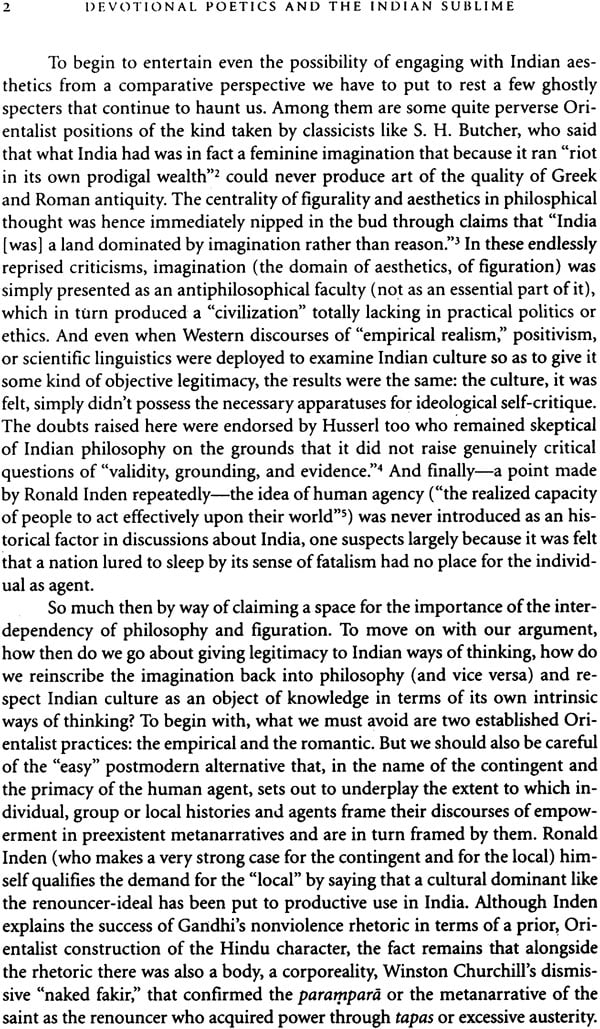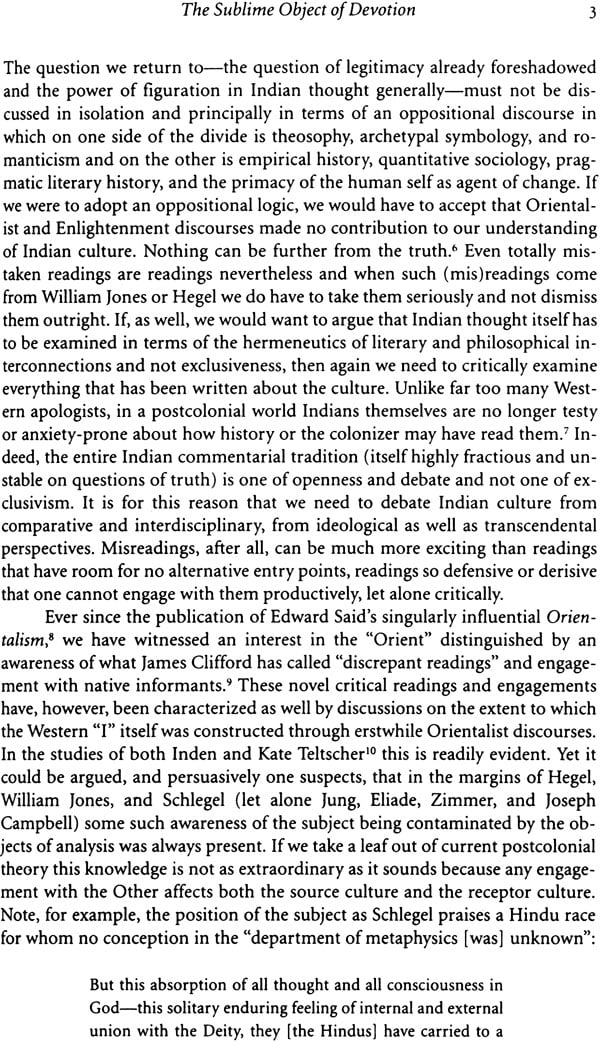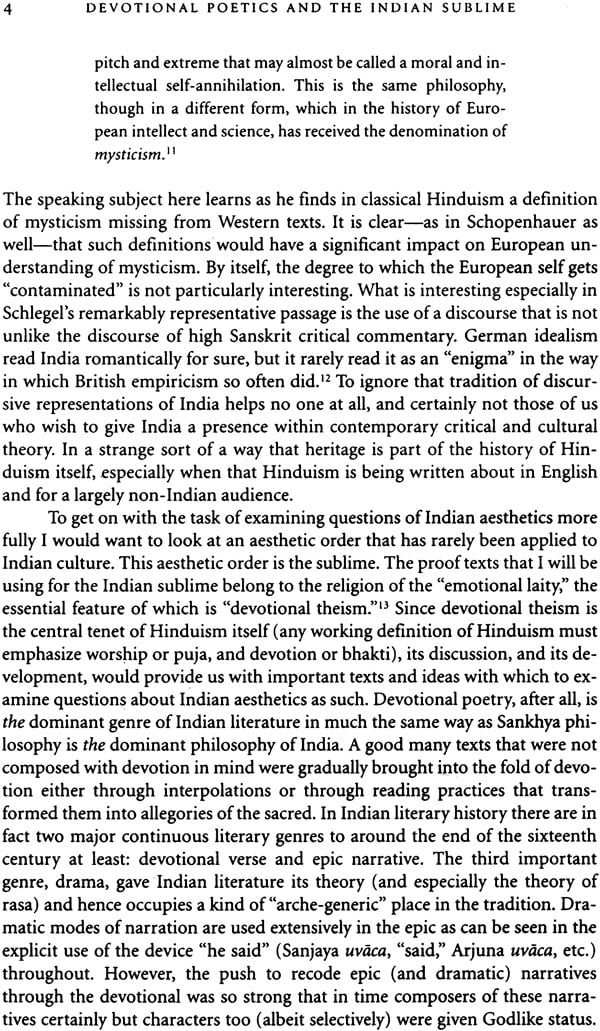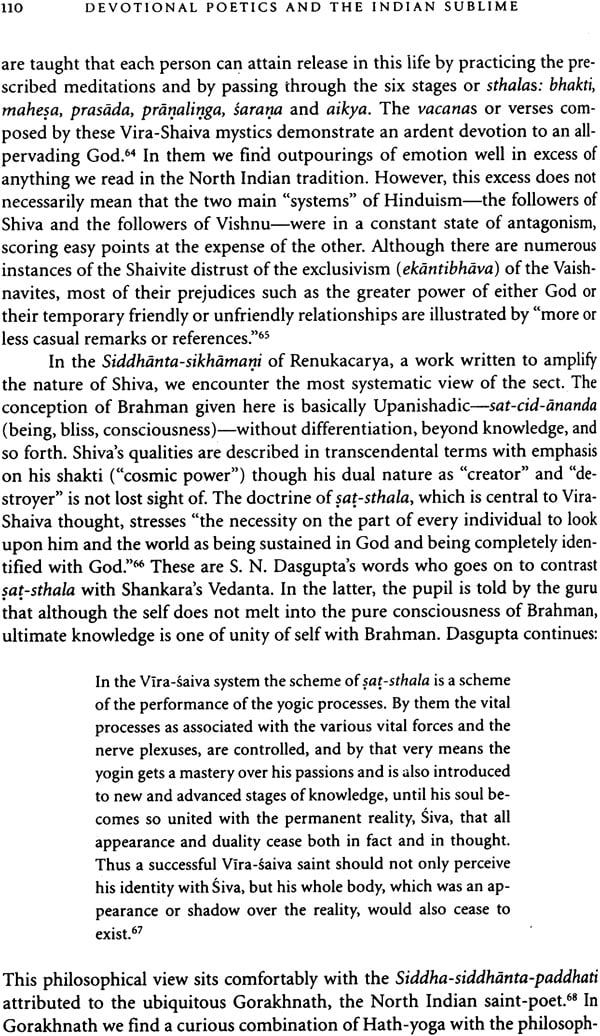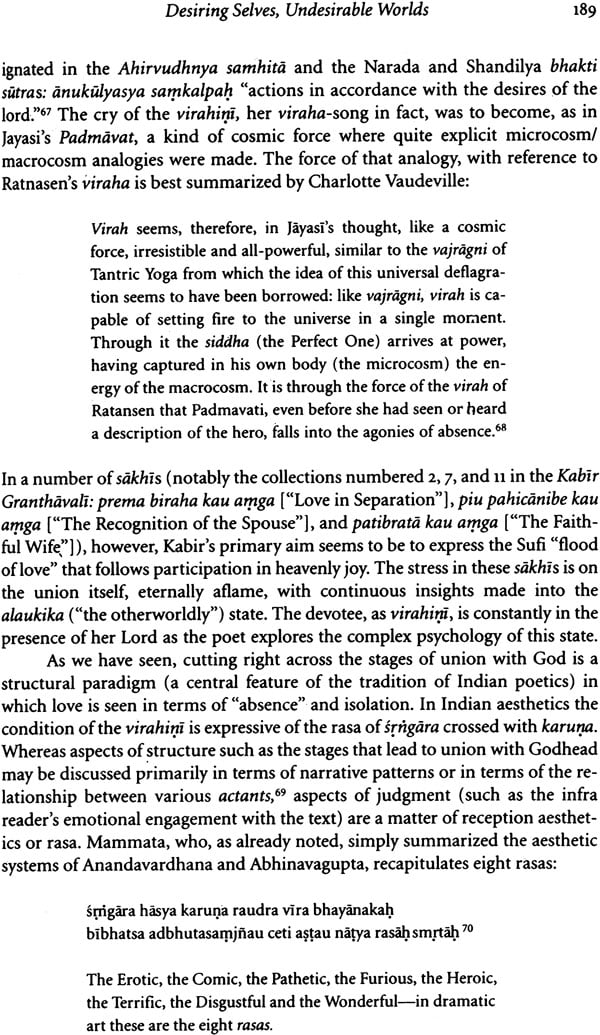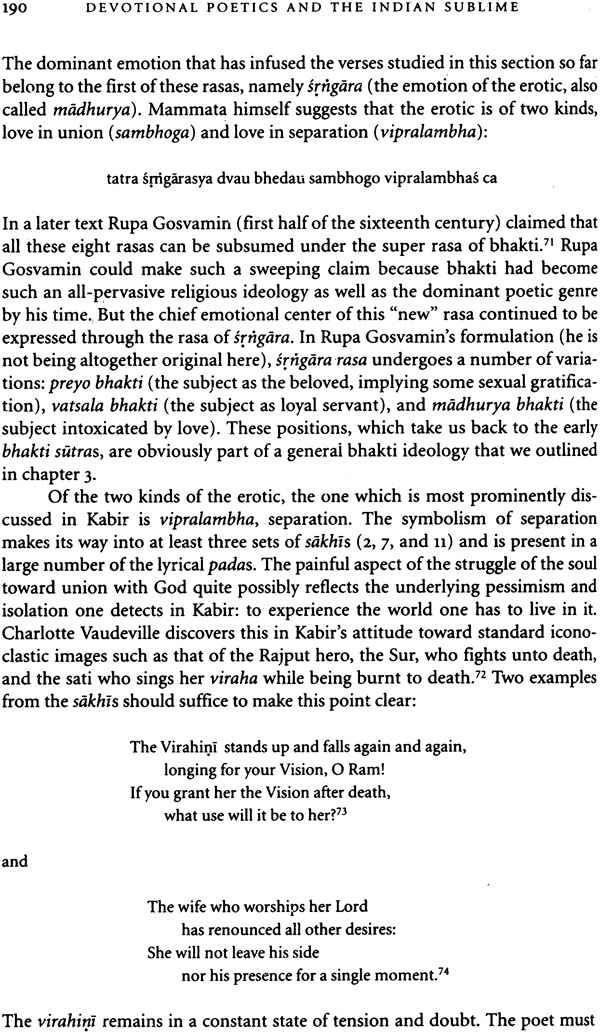
Devotional Poetics and the Indian Sublime
Book Specification
| Item Code: | IDD179 |
| Author: | Vijay Mishra |
| Publisher: | D. K. Printworld Pvt. Ltd. |
| Language: | English |
| Edition: | 2000 |
| ISBN: | 8124601569 |
| Pages: | 279 |
| Cover: | Hardcover |
| Other Details | 8.8" X 5.8" |
| Weight | 580 gm |
Book Description
From the Jacket:
The last two decades of the twentieth century have been marked by an immense revival of interest in the sublime, yet past studies have used Western texts as their archives. This book dramatically shifts the focus by examining a major instance of an Indian sublime: the Brahman. Mishra examines European theories of the sublime, reads them off against contemporary critical uses of the term (notable by Lyotard and Paul de Man) and propose that the Hindu Brahman constitutes an instance of one of the most fully developed of all sublime. The book is the first to offer a comprehensive theory of both the Indian sublime and Indian devotional verse.
"The book offers a highly original interpretation of one fundamental problem in Indian cultural history: how des a devotee establish a relationship with God (Brahman) when God is ultimately incapable of representation? Mishra brilliantly exposes this problem by introducing the theme of the sublime and shows how the problem has been confronted across a range panorama of historical time and several Indic languages."
Abut the Author:
Vijay Mishra is Professor of English literature at the University of Albera, Canada. He is the author of The Gothic Sublime, also published by State University of New York Press, and (with Bob Hodge) Dark Side of the Dream: Australian Literature and the Postcolonial Mind.
In his breathtaking survey of Western readings of India Ronald Inden (Imagining India) warns us against a number of things that, against his advice, I undertake in this book. I speak of the Hindu mind; I collapse Indian thought with Hinduism; I equate classical or high Hinduism with "monist pantheism" and I use discourses obviously supplied by European psychology, heirs to what Inden calls the "degenerative psychohistory masterminded by Hegel" (129), to advance my argument. I also look upon the work of the poststructuralists much more favorably and find Madeleine Biardeau's and David Shulman's studies particularly useful. I find in their works readings that deconstruct two dominant visions of India-the despotic and the quasifeudal through the concept of the "decenteredness" of Indian culture. I can see an initial unease on the part of someone like Inden toward this book. This reader would say that my book removes agents out of Indian history and underplays local, contingent moments in favor of what Inden has called the mystique of "the Grecian urn of archetypes." The criticism would, however, be only partly true. For what my book tries to do is examine the connection between the contingent-the moment when the self recognizes its being in history-and the metanarratives through which the culture defines the contingent. The argument here is that in Indian culture, metanarratives continue to have meaning even as the subject enters the social or the "real." In the various texts of Hinduism that I examine-from the canonical Sanskrit texts to the vernacular compositions of itinerant singers-human agents affirm the value of tradition even as they question its ideology.
Surely to examine the ways in which Hinduism is systemic is not to de- historicize the religion but to demonstrate how movements and ideas are historically reworked within parameters that remain largely unchanged in culture, and how the Hindu desire to "push an idea to its logical extreme" leads to the creation of absolutist categories (such as the Law of Dharma) with their own "historical depth and enduring features" that produce an intentional chasm between the self and the social order, between the renouncer and the man-in- the-world. There is no better proof text of such absolutist categories in Hindu life than Indian popular cinema where a film such as Aisi Bhi Kya Jaldi Hai ("What's the Rush?" 1996) cannot finally accept that a daughter brought up by her father may want to return to her father on her wedding night. Popular cinema, rather than art cinema (where the narrative of implied incest may be permissible) carries the grand metanarratives of Hinduism and shows the complex ways in which Indian agents function within (and not against) prior metanarratives. In the context of this larger design, what the book attempts to do is bring to Indian culture a hermeneutic pluralism. However, in redressing idealist or romantic or even racist European readings of India I do not want to affirm another kind of essentialism, the kind that believes that comparative theory cannot be applied to different cultures and the kind that gives an unproblematic primacy to the native informant. The native informant is read with sensitivity in this book but never prioritized in an unproblematic manner. And comparative literary theory is strategically applied throughout.
The literary archives that form the basis of this study are well known and hence there is little in this book that would not be familiar to people who are interested in Indian languages and culture. The book, however, does attempt to make aspects of the Hindu world available to the interdisciplinary student of English and Comparative Literature, and Cultural Studies. In my translations, especially, I have kept this wider reader in mind. The translations from Sanskrit and from Old and Middle Hindi, in particular, are meant to be user-friendly and attempts have been made not so much for literal sincerity as for artistic correspondence. By the latter I mean translations that capture the aesthetic de- sign and feeling of the original rather than their prosaic meanings even if this results in what George Steiner has called "upward betrayal." A great poet like Tulsidas is simply unreadable in literal translations. What is worse, the non- Hindi reader gets no sense of the real strengths of this remarkable epic poet from these translations. The Tulsidas translator has to acknowledge-as all translators must-that a translator is a traitor (traduttore traditore) and he/she may have to distort literal meaning to convey emotional and aesthetic feeling. As George Steiner observed in After Babel: "The translator invades, extracts, and brings home" (298).
While the final product, I hope, has been written with clarity and the argument is relatively straightforward, I must admit that the book has not been easy to write. This is largely due to the many stages the book has had to go through over its very long gestation period. The book began as a relatively straightforward literary history of North Indian bhakti (or devotional) literature. It then became an author study, then a philosophical study of the medieval Indian saint Kabir, and finally a study of the nexus between the emotional and the religious. It was the last of these that led to my reconceptualizing the various drafts through an understanding of the sublime. The "topicality" of the term aside, what struck me was the absence of the term in critical engagements with Indian culture. I felt that if any religion was truly sublime that religion was Hinduism and if any culture was "unpresentable" (because of its sheer complexity) that culture had to be Indian culture. And so I began to connect aesthetics with belief and began to rethink the contribution of the category of the sublime to our theorization of devotional aesthetics. It was only after I had read with great interest the theorization of the sublime from Longinus to Kant that it dawned on me that Indian devotional poetics may be theorized through the category of the sublime. The question that struck me immediately was: What indeed is the sublime object of devotion in a literary genre trying to come to grips with its object as something so vast that it is unpresentable to the imagination and to consciousness? It is this question of representation-and in particular of sublime (non) representation-and its lack that took me back to my earlier drafts and I began to rewrite my book very quickly by asking two fundamental questions: What is the nature of the Indian sublime? Is there something about the problematic of (non) representation in medieval Indian authors to which we can relate even now? The first of these is discussed at length, the second exists only as an anxiety in the margins of the text. Whether the argument finally works is for the reader to decide.
Many friends, and many libraries have helped me along in this long and arduous journey and I would like to thank them here. The research for this book was undertaken in the Bodleian, Oxford, the Menzies Library of the Australian National University, the Murdoch University Library, the University of Allahabad Library, the University of Delhi Library, the Sahitya Sammelan, Allahabad, and the Nagripracarini Sabha, Varanasi. I would like to thank the relevant staff of these libraries for their patience and help. When I began my re- search in India many years ago it was my good fortune to meet people like Agam Capoor and his family, who made an Indian from the diaspora feel so to- tally at home. During the long writing period of this book I became indebted, in both scholarly and human sense, to many people. Among them the following have been especially helpful: S. T. Arasu, Richard Barz, the late A. L. Basham, Wimal Dissanayake, John Frodsham, John Frow, David George, Peter Jeffery, W. H. McLeod, Meenakshi Mukherjee, Sujit Mukherjee, Michael O'- Toole, the late S. A. A. Rizvi, Horst Ruthr of, Krishna Somers, Parasnath Tiwari, Harish Trivedi, and Rob Wilson. Peter Reeves, an indefatigable supporter of Indian Studies in Australia, encouraged me to complete the book and has taken a keen interest in its development. Stella Baker and Cynthia Baker typed early drafts of this book while Diana Clegg, sometime secretary of the English and Comparative Literature Program at Murdoch University, transferred the text onto a word processor. My ideas were sharpened through discussions with my friends Greg Bailey and Bob Hodge, who are responsible for whatever is of enduring value in the ensuing pages and who would have written a much better book. Anonymous readers of the manuscript have made a number of suggestions and recommendations and I thank them for saving me from many pit- falls. Murdoch University has not only been the enlightened venue for my teaching and research for these past twenty years but has also awarded me travel grants to India, Great Britain, and the United States to undertake re- search. The award of a Large Grant by the Australia Research Council (albeit for a different project) meant that I had time enough during 1995-96 to edit this book. My many Indian friends in Perth (far too many to be named individually) have made discussions about Indian aesthetics such an exciting subject at their characteristically extravagant parties. I thank them all. My children Rohan and Paras and my wife Nalini have been and continue to be so thoroughly supportive of my research. It is not their fault that the book did not appear sooner or that it has not reached their standards of excellence.
| Preface | vii | |
| A Note on Transliteration | xi | |
| 1. | The Sublime Object of Devotion | 1 |
| 2. | Two Truths Are Told: Prologues to the Swelling Act | 43 |
| 3. | Devotional Poetics | 81 |
| 4. | Temples of Fire: Plurality-with-Unity | 129 |
| 5. | Desiring Selves, Undesirable Worlds | 163 |
| Conclusion: The Devotional Sublime | 199 | |
| Notes | 203 | |
| Select Bibliography | 239 | |
| Index | 263 | |

